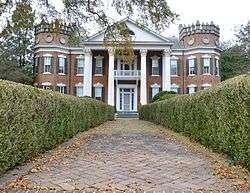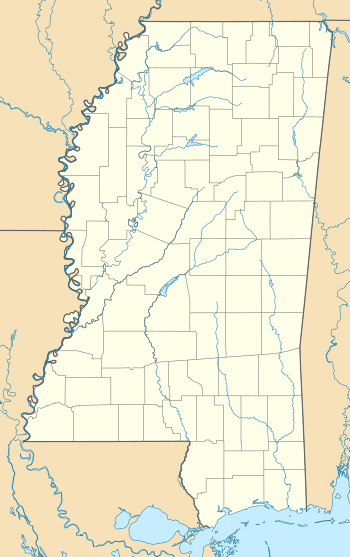Walter Place (Holly Springs, Mississippi)
Walter Place is a historic mansion in Holly Springs, Mississippi, United States. Built in 1860 for pro-Union Harvey Washington Walter, the President of the Mississippi Central Railroad. The mansion was the temporary home of Union General Ulysses Grant and his wife Julia Grant during part of the American Civil War. Later, it was the summer residence of Oscar Johnson, Jr., the co-founder of the International Shoe Company. A combination of Greek Revival and Gothic Revival architectural styles, it was the most expensive house in Mississippi on the market in 2011.
Walter Place | |
 Walter Place in 2014 | |
  | |
| Location | 300 West Chulahoma Avenue, Holly Springs, Mississippi, U.S. |
|---|---|
| Coordinates | 34°45′58.2″N 89°27′17.1″W |
| Built | 1860; 1903 |
| Architect | Spires Boling; Theodore C. Link |
| Architectural style | Greek Revival, Gothic Revival |
| Part of | Southwest Holly Springs Historic District (ID83000963[1]) |
| Added to NRHP | April 20, 1983 |
Location
The mansion is located at 300 West Chulahoma Avenue in Holly Springs, a small town in Marshall County, Northern Mississippi.[1]
History
Construction on the two-storey mansion began in 1857,[2] and it was completed in 1860.[1][3] The architect was Spires Boling.[4] He designed it as a combination of Greek Revival and Gothic Revival architectural styles.[1][5] It has a portico with four Corinthian columns flanked by octagonal turrets on both sides.[1] The tympanum of each tower has lunette windows.[1]
It was built for Colonel Harvey Washington Walter,[3] a lawyer who served as the President of the Mississippi Central Railroad.[6][7] During the American Civil War of 1861-1865, Walter, who was opposed to secession, invited Union General Ulysses Grant to live in the house.[2][3][6] As Confederate General Earl Van Dorn liberated Holly Springs, he was not permitted to enter the house until Julia Grant had gone outside.[8] Moreover, the house could not be ransacked.[8] As a result, it was used by Confederate personnel and intelligence officers.[8]
Other sources, including Julia Grant's memoirs, give a slightly different version of events saying that she had left Holly Springs before Van Dorn and his troops arrived. Some of the troops attempted to remove her personal belongings from the house, but were prevented by Mrs. Pugh Govan, who was looking after Walter Place. Julia Grant's carriage was burned and her horses taken, but this would have been in line with Van Dorn's plan to remove or destroy anything in the area that may have benefited the Union army.[9]
A decade later, during the yellow fever epidemic of 1878, the mansion was used as a quarantine hospital for patients.[3][6] Colonel Walter and three of his sons died from the disease that year and the mansion was then inherited by his widow, Fredonia.[4] In 1889, it was purchased by her son-in-law, Oscar Johnson, husband of daughter Irene.[3] Johnson was a co-founder of Roberts, Johnson & Rand Shoe Company, a shoe company in St. Louis, Missouri later known as the International Shoe Company.[4] The Johnsons added a formal landscape garden and summered at the mansion.[3] In 1903, they hired German-born architect Theodore C. Link to remodel the house.[1][4]
In 1918, two years after Johnson's death, his widow sold the house to A. M. Green.[4] Green, who was a Ford car dealer, redeveloped the garden.[4] However, by 1934, Johnson's children purchased the property again at an auction, for US$4,000.[4] However, it was mostly lived in by hired help.[4] The mansion was acquired by preservationists who restored it in the 1970s.[6] It was listed as the most expensive house in Mississippi in 2011, for US$15 million.[6] It was sold at an auction in 2014.[10]
Architectural significance
As a contributing property to the Southwest Holly Springs Historic District, it has been listed on the National Register of Historic Places since April 20, 1983.[1]
References
- "Southwest Holly Springs Historic District" (PDF). National Park Service. June 1984. Retrieved September 12, 2015. Includes photos of Walter Place, 17-18 of 70.
- Long, Alice; Ridge, Mark L. (2006). Holly Springs. Gretna, Louisiana: Pelican Publishing Company. pp. 34–35.
- Kempe, Helen Kerr (1998). Marshall County: From the Collection of Chesley Thorne Smith. Gretna, Louisiana: Pelican Publishing Company. p. 30.
- Miller, Mary Carol (2007). Must See Mississippi: 50 Favorite Places. Oxford, Mississippi: University Press of Mississippi. pp. 183–184.
- "Places of Interest". City of Holly Springs, Mississippi. Retrieved September 12, 2015.
- "Mississippi's Most Expensive Mansion Once Slept Ulysses Grant". The Atlantic. November 4, 2011. Retrieved September 12, 2015.
- Higginbotham, Sylvia (2000). Marvelous Old Mansions: And Other Southern Treasures. Winston-Salem, North Carolina: John F. Blair, Publisher. pp. 118–120.
- Kirkpatrick, Marlo Carter (2010). Mississippi Off the Beaten Path: A Guide to Unique Places. Lanham, Maryland: Rowman & Littlefield. p. 18.
- Ryan P., Ryan P.; Nolen, David S. (2013). "War and Remembrance: Walter Place and Ulysses S. Grant,". University of Southern Mississippi; The Primary Source. 32 (2 Article 1). Retrieved 31 January 2016.
- Watson, Sue (July 10, 2014). "Walter Place and contents for sale". The South Reporter. Holly Springs, Mississippi. Retrieved September 12, 2015.